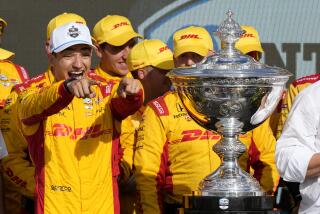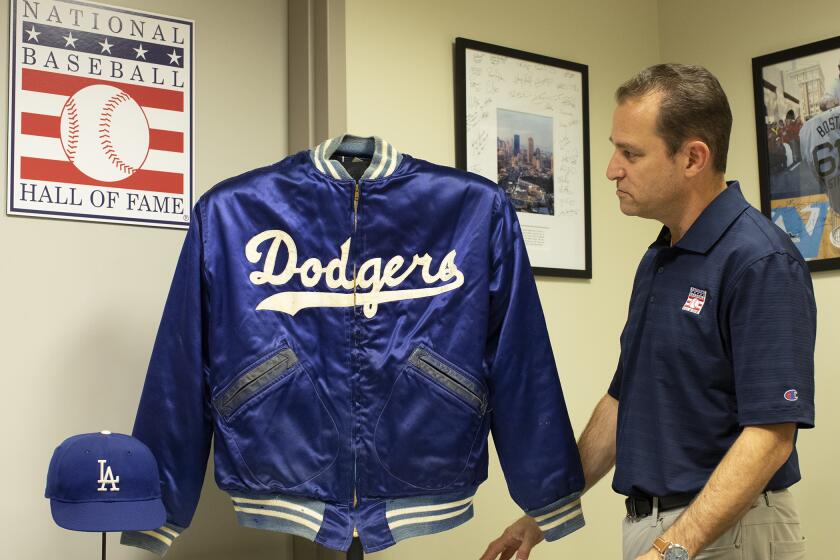AUTO RACING : Earnhardt Apparently Is Set for a Move Toward the Front
- Share via
That rumbling you hear from NASCAR-land may be the awakening of a sleeping giant--Dale Earnhardt.
The two-time defending and five-time Winston Cup champion is off to what for him is a very slow start. Seven races into the season, no victories and eighth in the series standings, trailing leader Davey Allison by 202 points.
A year ago, after seven races, Earnhardt was third, 142 points behind Ricky Rudd, who eventually wound up second.
But the signs are there in the last few races that Earnhardt and the rest of the Richard Childress Racing team are ready to begin a move toward the front.
After going five races without leading a lap, Earnhardt has made it to the front in each of the last two events. He now has four top-10 finishes this season, with three of them coming in the last four races.
“It’s still early enough to get things turned around,” Earnhardt said. “I’ve had seasons that were more frustrating than this one has been. In 1985, we were blowing engines and had bad luck all year. That was really bad.”
He finished eighth that season, the last time he has been lower than third in the final standings.
One problem has been the early dominance of Ford, which has won all seven races--four by Bill Elliott, two by Allison and one by Alan Kulwicki. The Chevrolet teams, which include Childress, have struggled to get going after having won an unprecedented nine straight NASCAR manufacturers’ titles.
“We’ve just had some tough luck, but I’m keeping a positive attitude,” Earnhardt said. “The team is working hard to get better every race and I don’t look at the gap between Ford and Chevrolet, if there is one. I look at our team’s performance. I’m working as hard as I can as a driver, and the team is working as hard as they can. I’m not worried about the competition.”
There is again quiet but real concern among officials at the Indianapolis Motor Speedway about the paucity of entries for the May 24 Indianapolis 500.
The final entry list shows 95 cars entered, but only 37 of them are assigned to drivers, and nine of those drivers are Indy rookies, some of them with no previous experience on an oval track.
Concerns last year proved unwarranted when the final 33-car field turned out to be the fastest and deepest in history. Still, there were only four bumps--drivers knocked from the field by a faster qualifier once the lineup is full.
One optimistic note, however, is the fact that a number of unassigned cars could wind up in the capable hands of drivers still looking for a ride.
That includes four-time Indy winner Al Unser, three-time Indy winner Johnny Rutherford and former winner Tom Sneva.
Most of the unassigned cars are 1991 or 1992 Lolas or Penskes with Cosworth, Buick or Judd power--meaning none of them would be on the cutting edge of available technology.
Still, with a four-lap, 10-mile average of about 214 m.p.h.probably needed to make the race, those cars could conceiveably be in the running.
Practice opens next Saturday, with time trials scheduled May 9-10 and May 16-17.
NASCAR’s Winston Cup series finishes its first round of short tracks for this season with the Hanes 500 this Sunday at Martinsville, Va. The race on the .526-mile oval will be the last for the stock cars on a track shorter than one mile until they run on Aug. 29 at Bristol, Tenn.
In fact, from June 7 (at Sears Point in Sonoma, Calif.) through August 16 (at Michigan International Raceway), every Winston Cup event will be contested on tracks two miles or longer.
Martinsville could well be the place that Chevrolet finally gets things going in its direction after going 11 straight races without a victory--dating to a Dale Earnhardt win last Sept. 29 at North Wilkesboro, N.C.
Chevys have won a total of 15 races on the half-mile oval, including four of the last five and 13 of the last 20. During that period, Ford has won three times, Buick twice and Pontiac and Oldsmobile once apiece.
It took 31 years for Top Fuel dragsters to go from 200 m.p.h.to 300 m.p.h.
The awesome 301.7 on March 20 at Gainesville, Fla., by Kenny Bernstein had become inevitable in recent months, but it was once thought to be an impossibility.
When Chris Karamesines, Chicago’s “Golden Greek,” turned a 204.54 top speed on April 4, 1960 at Alton, Ill., Dragway, that was thought to be near the terminal speed for piston-driven cars on a quarter mile strip.
And the climb has been a slow one.
The 250 run didn’t come until Oct. 11, 1975 when “Big Daddy” Don Garlits accomplished it at Ontario, Calif., Motor Speedway.
The next 10 m.p.h took nearly nine years, with Joe Amato hitting 260.11 at Gainesville on March 18, 1984.
Garlits made it to 272.56 on March 23, 1986 at Gainesville, Amato raised the standard to 282.13 on Sept. 5, 1987 at Indianapolis Raceway Park, and Connie Kalitta was the first to reach 290, hitting 291.54 on Feb. 11, 1989 at Pomona, Calif., Raceway.
What’s next?
“I don’t think we’ll see any real big jumps for a while,” Bernstein said. “But there are going to be some more 300s, maybe 304 or 305 before the end of this year.”
Ian Ziering, who is a regular in the hit TV series “Bevery Hills 90210,” has caught the racing bug after taking part in the recent Toyota Pro-Celebrity event at the Long Beach Grand Prix.
Ziering finished third in the celebrity division of the 10-lap event and said, “It was incredibly exciting and I’m glad that I had the chance to race. But Aaron (executive producer Aaron Spelling) said that if I broke my leg, he was going to break the other one.”
More to Read
Go beyond the scoreboard
Get the latest on L.A.'s teams in the daily Sports Report newsletter.
You may occasionally receive promotional content from the Los Angeles Times.










